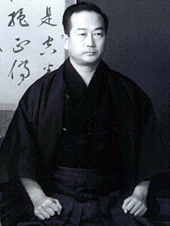Masatoshi Nakayama facts for kids
Quick facts for kids Masatoshi Nakayama |
|
|---|---|
 |
|
| Born | April 13, 1913 Yamaguchi Prefecture, Empire of Japan |
| Died | April 15, 1987 (aged 74) Tokyo, Japan |
| Style | Shotokan karate |
| Teacher(s) | Gichin Funakoshi, Gigō Funakoshi, Isao Obata, Takeshi Shimoda |
| Rank | 10th dan Karate |
| Notable students | Keigo Abe, Tetsuhiko Asai, Keinosuke Enoeda, Hirokazu Kanazawa, Shojiro Koyama, Takayuki Mikami, Cary-Hiroyuki Tagawa Teruyuki Okazaki, Hidetaka Nishiyama, Taiji Kase, Hiroshi Shirai, Masaaki Ueki, Hideo Ochi, Masahiko Tanaka, Yutaka Yaguchi, Shigeru Takashina, Stan Schmidt, Toshihiro Mori, Takenori Imura, Minoru Kawawada, Hideo Yamamoto, Takashi Yamaguchi, Yoshiharu Osaka, Yasunori Ogura, Ilija Jorga, Tomio Imamura, Seizo Izumiya, Katsutoshi Shiina, Yasuo Hanzaki Vilaça Pinto |
Masatoshi Nakayama (中山 正敏, Nakayama Masatoshi, April 13, 1913 – April 15, 1987) was a very famous Japanese master of Shotokan karate. He helped create the Japan Karate Association (JKA) in 1949. He also wrote many books about karate. These books helped make his martial art popular around the world.
For almost 40 years, until he passed away in 1987, Nakayama worked hard. He wanted to share Shotokan karate with people everywhere. He was the first Shotokan master to reach the rank of 9th dan while he was alive. After his death, he was given the even higher rank of 10th dan.
Contents
Early Life and Karate Journey
Masatoshi Nakayama was born on April 13, 1913. This was in the Yamaguchi Prefecture of Japan. His family, the Sanada clan, were known for teaching kenjutsu (sword fighting). His grandfather, Naomichi Nakayama, was a surgeon in Tokyo. He was also the last in the family to teach kenjutsu.
Nakayama's father, also named Naomichi Nakayama, was an army doctor. He was also a judoka (someone who practices judo). Because his father was sent to Taipei, Nakayama spent some of his younger years there. Besides his school studies, he enjoyed many sports. He played kendo, went skiing, swam, played tennis, and ran track.
In 1932, Nakayama went to Takushoku University. He planned to study Chinese language. He also started learning karate there. His teachers were Gichin Funakoshi and his son, Yoshitaka (also called Gigō). Nakayama had actually planned to continue his kendo training. But he read the schedule wrong and ended up at karate practice instead! He found it very interesting and decided to join the karate group.
Nakayama finished university in 1937. That same year, he went to China. He worked as a military interpreter during the Second Sino-Japanese War. By the time World War II started, Nakayama had reached the rank of 2nd dan in karate. He returned to Japan in May 1946, after the war ended.
Building the Japan Karate Association
In May 1949, Nakayama and his friends, including Isao Obata, helped create the Japan Karate Association (JKA). Gichin Funakoshi was the official head of the group. Nakayama was chosen as the Chief Instructor. This was because he was the only one without a job at the time. So, he could open and close the dojo (training hall) every day.
By 1951, Nakayama was promoted to 3rd dan. By 1955, he held the rank of 5th dan. In 1956, he worked with Teruyuki Okazaki. They changed the Shotokan karate training program. It now combined traditional karate with new ideas from modern sports sciences. In 1961, Nakayama was promoted to 8th dan. This was a very fast rise in rank!
Nakayama made kata (patterns of movements) and kumite (sparring) important parts of karate tournaments. Students from the big JKA dojo then won many tournaments in the 1950s and 1960s.
Nakayama is famous for helping to spread Shotokan karate all over the world. He and other senior instructors started a special program. This program trained new JKA instructors. Many of these trained instructors were sent to different countries. Their job was to start new Shotokan groups and get more people to join. Nakayama also worked at Takushoku University. He started in the Physical Education department in 1952. Eventually, he became the head of that department. He also led the university's ski team.
Later Years and Lasting Impact
In 1972, Nakayama opened his own personal dojo. It was in the basement of his apartment building. He called it "Hoitsugan." This dojo was in Ebisu, Tokyo, close to the main JKA headquarters. From the early 1970s, karate students from outside Japan lived in dorm rooms there. They trained in this dojo.
After his quick promotions in the 1950s, Nakayama was still an 8th dan in 1974. He was promoted to 9th dan in the 1980s. This made him the first Shotokan master to reach this rank while still alive. Masatoshi Nakayama continued teaching Shotokan karate until he passed away on April 15, 1987, in Tokyo, Japan.
Legacy of Knowledge
Nakayama wrote many books about karate. His most famous work is the 11-volume Best Karate series. He also had many video productions about karate. Some of his books include:
- Practical Karate: A guide to everyman's self-defense (1963, co-authored)
- Practical Karate: Defense against an unarmed assailant (1963, co-authored)
- Best Karate: Comprehensive (1977)
- Dynamic Karate (1986)
A well-known martial arts writer, Donn F. Draeger, helped Nakayama write some of his books.
After Nakayama's death in 1987, the JKA faced some challenges. Many senior JKA instructors left to start their own karate groups. This shows how much influence Nakayama had on the world of Shotokan karate.
See also
 In Spanish: Masatoshi Nakayama para niños
In Spanish: Masatoshi Nakayama para niños
- List of Shotokan organizations

